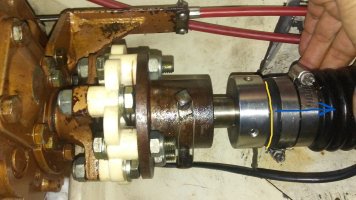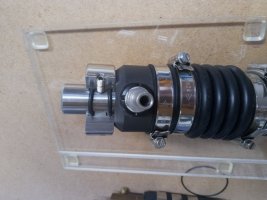Thank you ALL for your helpful suggestions. Let me try to respond to a few of your comments below. Further advice is most welcome.
Rechecking alignment and the mounts: Apologies for my novice mechanical background...but how do I recheck alignment while the boat is in the water? I can definitely look at the mounts and ask the yard whether they are softer than the old ones. I do know that the new ones are Westerbeke engine mounts (32013). Unfortunately I don't know anything about the old ones except that the engine survey said they were "fairly solid...but that the rubber portion was starting to break down and may not provide proper vibration dampening." This was discovered soon after we made an offer on the boat and since it was already on the hard for bottom painting, we had the yard replace them. They said that they checked alignment on the hard, as well as in the water after 24 "hours splash."
Barnacle growth or kelp or other detritus: The boat is in fresh water but we have had a lot of debris copming down the Columbia river during spring thaw. I'm not a diver but others in our club said they are getting together to have a diver come out and clean the bottom. I will definitely have them inspect the prop (which is a folding prop), as well as turn it from inside the engine bay.
Transmission fluid: When on the hard, I had the yard remove and replace engine oil, several filters (oil, fuel, air, water), impeller, engine anodes and alternator belt (which sounded normal to me and tension seemed fine). I actually don't see transmission fluid listed on the invoice and I'll check it anyway and ask the yard if it was replaced. Thanks Loren for the tip on removing the heat exchanger. Christian mentioned testing the transmission in fwd and reverse. Can you provide a bit more detail re what to look for?
Tension, burping and vent tube on the PSS: We had significant PSS maintenance done including removing the coupler fasteners and removing the coupler from the shaft, removing the old PSS assembly and resurfacing the SS rotor, setting new PSS seal compression, and checking engine alignment. Everything on our 4 hour motor return from the yard sounded fine. However, when I crawled in the aft cabin to directly look at the PSS and engine while motoring Sunday, I could hear the squeaking noise aft of the PSS (but I can only see a couple feet aft). I can reach out to PSS techs to see how to check the tension. The engine seemed to sound fine with no extra vibration. There is no vent on the PSS. it is plugged. I tried to look online to see how to burp it but it must be so obvious everyone (but me) knows exactly how to do it. I can ask a couple others near our boat, but I think I have seen it done in one of Christian's videos. I will feel to see how warm it is after motoring a bit when we head out next.
Many thanks!!


